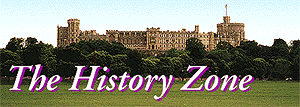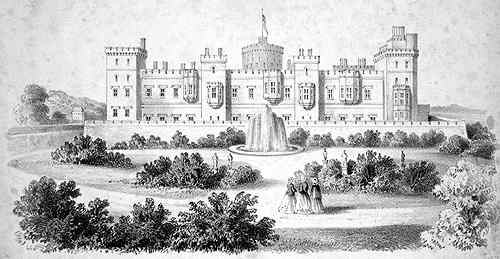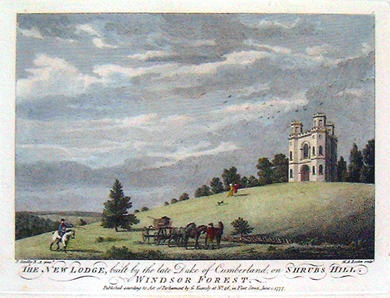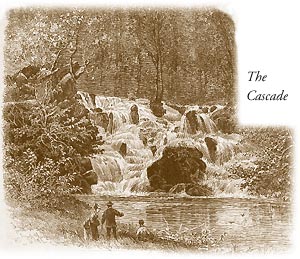 
|
||||
8 The Royal Lodges and Parks |
 
|
||||
8 The Royal Lodges and Parks |
8 An Account Of Royal Lodges, Parks, etc.Windsor is not more renowned for being the seat of Royalty, than on account of its delightful situation; the beauties of which appeared so striking to a royal personage, on her first visit to this place, that she is said to have exclaimed: "This is a palace indeed!"
Adjoining to the Park, and opposite the south side of the Castle, is a neat modern-built mansion, named the Queen's Lodge; and a little to the south-west of this is another spacious building, which formerly belonged to the Duke of St. Alban's; but having been purchased and repaired by his present Majesty, and forming a part of the royal residence, is now denominated the Lower Lodge. These buildings command a pleasant prospect over the Parks and the neighbouring country, and contain many elegant apartments; however, as they are not shown to the public, a description of them is not only unnecessary, hut might perhaps be thought improper; we shall therefore only presume to point out one article, and that on account of its originality. In the beginning of the year 1789, a ceiling was affixed up in the Drawing Room of the Queen's Lodge, by an artist of the name of Haas, of a peculiar and novel art, to which no name has as yet been applied; but the figures are in imitation of, and have all the force and effect of the best oil painting; with this great advantage, that the various groups of figures may be distinctly seen at any point of view. Only one simple article is used by the artist, which is stained marble dust, this is strewed with a piece of card, either on board or canvass. The composition of, as well as the manner of using the cement, is known only to the artist himself, which, upon trial, has been proved to resist the various changes of weather. The ceiling consists of several subjects. In the centre, in an oval, is genius reviving the arts; in the four corners are agriculture, manufactory, commerce, and riches, depicted by emblematical figures in the different vocations, with the symbols of the several sciences. The intermediate compartments are in imitation of bas-relief and are representation of astronomy, navigation, electricity, geography, fortification, gunnery, chemistry and botany. The whole is beautifully ornamented with festoons of oak leaves interspersed with roses, lilies e and thistles: the arms of the royal family, etc. This is the first production of the artist, except some few portraits, in which he has been tolerably successful. The subjects of the ceiling are from the designs of Benjamin West, Esq. The Little Park, [now known as the Home Park. Ed.] which extends round the north and east sides of the Castle, is a beautiful lawn, computed to be four miles in circumference, and contains about 500 acres of land. This Park was enlarged and enclosed by a brick wall, in the reign of King William III, and is admired for its shady walks and natural beauties. A delightful plain, on the top of the hill, was so converted into a bowling green, by King Charles II but its eminence rendering the view from the east side of the terrace somewhat confined, it has been considerably lowered, by order of his present Most Gracious Majesty; [George III] and the earth taken from the summit of the plain, spread on the declivity of the hill, which is planted with various kinds of forest trees, and the whole enclosed with a neat park paling.  drawn after the alterations to the Round Tower This Park, on the north side of the Castle, was laid out for a garden, by order of Queen Anne, but on that princess's deaths the design was laid aside, it being thought that the beauties of nature here render all the decorations of art unnecessary; the beds, parterres, etc., laid out by Her Late Majesty, have all been levelled, and the whole formed into a spacious lawn. Previous to the latter end of the year 1785, numerous herds of deer were kept in this Park; but since that time it has been flocked with sheep, and cattle of various denominations; yet there are still some deer remaining, and plenty of hares, which frequently afford His Majesty the diversion of coursing. The Ranger's Lodge, at the south-east side of the Park, formerly the residence of the late Earl of Pomfret, when Ranger, is a regular well-built edifice. General Granville is the present Ranger, but the Lodge is retained by the King; contiguous to which is the Royal Dairy; also, the kennel for His Majesty's harriers. Near to this, on the opposite side of the road, is Frogmore, where there is an elegant mansion, formerly the seat of Sir Edward Walpole, and lately that of Mr B. Egerton. This estate, being held under a lease from the Crown, which was nearly expired, the Queen, in 1792 became the purchaser of it; and since then has made very considerable additions, both to the house and gardens. The latter have been enlarged by the addition of those formerly belonging to a house that some years since was the seat of Mrs. Macartney; and which, at various times, had been the residence of many respectable families. This having likewise been purchased by Her Majesty, was taken down in 1795, to render the before-mentioned improvements more complete. The Great Park lies on the south side of the town, and opens by a very noble road, called the Long Walk, on each side of which is a double plantation of stately trees, to the summit of a delightful hill, called Snow-Hill, at near three miles distance from the entrance; this leads to the Ranger's lodge, formerly the seat of His late Royal Highness, the Duke of Cumberland, and also of the late Duke William of Cumberland, to whom it was given in the year 1744. The last mentioned duke greatly improved the natural beauties of this delightful park by large plantations of trees, extensive lawns, new roads, and spacious canals, which have rendered this villa an habitation worthy of a prince. In various parts of the park, considerable farms have been made, by order of his present Majesty, which are severally named after the agricultural experiments tried at them; viz. one is called the Norfolk, another the Suffolk, and a third the Flemish Farm; at each of which respectively, the particular mode of culture, peculiar to each county, is practised. In addition to these, a fourth farm has lately been projected; but its denomination we have not learnt. The rangership of this park not having been disposed of, since the demise of His late Royal Highness, the Duke of Cumberland, the only inhabitants of the lodge at present are a few domestics. The Belvidere [Belvedere] on Shrub's Hill is a triangular building that has a tower at each corner, one of which is a staircase, the other a library, and the third a china closet. It is encompassed by a fine plantation of trees, forming a most delightful rural scene. The noble piece of water in the valley beneath, was formed at a great expense, and, from a small stream or current ; is rendered capable of carrying barges and boats of pleasure. Over this water the late Duke William caused a bridge to be erected of most curious architecture, on a bold and noble plan, being one single arch, 165 feet wide in the clear, which is five feet wider than the boasted Rialto at Venice.  but illustrated here by a print from a similar period This piece of water terminated in a large and beautiful cascade; but a few years since, the pond head blowing up, the rapidity of the torrent did such material damage to the bridge, that the whole was obliged to be entirely taken down, and a stone one has lately been erected, consisting of five arches. The dam, or mound, which confines this vast body of water, 'till it rises to the summit of an artificial rock, is formed upon a large scale, at a very considerable expense.  [from 'Picturesque Europe' published in the 1870s] About half a mile from this bridge is the Chinese Island, so named from the building on it being after the Chinese manner. Besides the improvements already mentioned, the race ground on Ascot Heath was laid out, and brought into the most beautiful order, at a large expence, by Duke William, and is allowed to be one of the first courses in the kingdom. The Forest is of great extent, and was appropriated to hunting by William I. who established many laws and regulations, which are still observed, for the preservation of the royal game, and better regulation of the forest. In this extensive tract of land, are several pleasant villages and gentlemen's seats; for an account of which, together with the other remarkable places in the environs of Windsor, we shall refer the reader to the Compendious Gazetteer, annexed to the Pocket Companion to Hampton Court.
|
8 The Royal Lodges and Parks |